Buick Skyhawk
The Buick Skyhawk is an automobile produced by Buick in two generations for the 1975 through 1989 model years.
| Buick Skyhawk | |
|---|---|
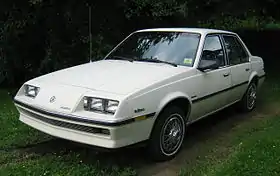 1986 Buick Skyhawk Custom 4-door sedan | |
| Overview | |
| Manufacturer | General Motors |
| Production | 1974–1989 |
| Model years | 1975–1980 1982–1989 |
| Body and chassis | |
| Class | Subcompact (1975–1980) compact (1982–1989) |
| Chronology | |
| Predecessor | Buick Opel |
The first generation (1975-1980) were two-door hatchbacks using the subcompact, rear-wheel drive H-body platform, a badge engineered entry-level version of the Chevrolet Monza, which was based on the Chevrolet Vega.
The second generation (1982-1989) models were built on the compact, front-wheel drive J-car platform that was available in four body styles: two-door sedan and hatchback, as well as four-door sedan and station wagon — manufactured alongside its rebadged variants, the Chevrolet Cavalier, Cadillac Cimarron, Oldsmobile Firenza, and Pontiac J2000/2000/Sunbird at GM's South Gate Assembly and Janesville Assembly plants.
First generation (1975–1980)
| First generation | |
|---|---|
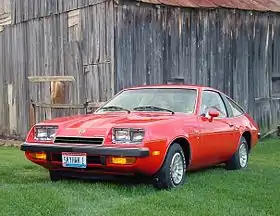 1975 Buick Skyhawk hatchback coupe | |
| Overview | |
| Production | 1974–1979 |
| Model years | 1975–1980 |
| Assembly | Lordstown, Ohio, United States Sainte-Thérèse, Quebec, Canada |
| Body and chassis | |
| Class | Subcompact |
| Body style | 2-door hatchback |
| Layout | FR layout |
| Platform | H-body |
| Related | Chevrolet Monza Pontiac Sunbird Oldsmobile Starfire |
| Powertrain | |
| Engine | 3.8 L 231/LD5 V6 |
| Transmission | 4-speed manual 5-speed manual 3-speed automatic |
| Dimensions | |
| Wheelbase | 97 in (2,464 mm) |
The "first generation" Buick Skyhawk is a subcompact, four passenger, hatchback automobile that was introduced September 1974, and produced for the 1975 through 1980 model years. It was based on the Chevrolet Vega, and shares its wheelbase and width.[1] The Skyhawk was produced with H-body variants Chevrolet Monza, Oldsmobile Starfire, and Pontiac Sunbird. In North America, it competed with other small sporty cars, such as the Toyota Celica, Datsun 200SX, VW Scirocco, Mercury Capri, and the Ford Mustang II. The Buick Skyhawk was the smallest car to wear the Buick badge in more than 60 years.
Overview
The Skyhawk has a 97.0-inch (2,460 mm) wheelbase and a 65.4-inch (1,660 mm) width. The Skyhawk, Chevrolet Monza, and Oldsmobile Starfire were among the first vehicles to adopt the newly approved quad rectangular headlamps. The body style is noted for having a resemblance to the Ferrari 365 GTC/4. The Skyhawk is a rear-wheel drive vehicle with a live rear axle design. Throughout its production, the H-body Skyhawk was offered only with the Buick-designed 3.8 liter (231 cid) V6 engine, using a two-barrel carburetor that generated 110 hp (82 kW) at 4000 rpm in comparison to its siblings which offered a variety of engines. A four-speed manual transmission was standard; with a three-speed automatic offered as an option. The front suspension is short and long control arms with coil springs, and anti-roll bar; the rear suspension is a torque-arm design with coil springs and an anti-roll bar. Its design was later incorporated into GM's third- and fourth-generation F-bodied (Camaro and Firebird). Variable-ratio power steering was standard and of a recirculating ball design. The brake system features standard power assist including front disc brakes with solid rotors, and rear drum brakes.
Changes
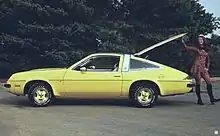
Following the introduction of the Skyhawk, in mid-1975, it was joined by a lower-priced and less well-equipped Skyhawk S.
In 1976, a five-speed manual transmission became available as an option. Starting with the 1976 models, the front and rear disc rotors were of the vented type. Another new option was the Astroroof, which was a large, heavily tinted, overhead glass roof combined with a wide aluminum band that extended from one B-pillar across the roof to the opposite B-pillar. In 1977, a conventional sliding sunroof became optional and also could be ordered with the aluminum band.
For the 1979 model year, the Skyhawk received a facelift that incorporated single rectangular headlamps, replacing the previous dual rectangular headlamps that all models had used. A new option was the "Road Hawk" package that included a Rallye ride and handling package consisting of larger front and rear stabilizer bars, larger tires, and special interior and exterior trim. There was also a "Skyhawk Designers' Accent Edition" that was primarily an exterior trim package available in bright yellow or red with black trim.
There were few changes for 1980, the last model year for the GM H-body platform, most notably the discontinuance of the five-speed manual transmission as an option. Only the four-speed manual and three-speed automatic transmissions were offered for 1980.
The H-body Skyhawk was replaced in the spring of 1981 with the new front-wheel drive Buick Skyhawk, built on General Motors' J-body platform. However, this new second-generation was not a direct replacement for the original Skyhawk. While the original Skyhawk was a small sporty car, the second-generation model was a line of compact cars that included two- and four-door sedans, a two-door hatchback coupe, and a four-door station wagon.
The Skyhawk and Starfire failed to achieve the sales success of the Monza and Sunbird possibly because small sporty coupes seemed out-of-place in a Buick or Oldsmobile showroom. Lack of a notchback model may have also been a factor. They were discontinued on December 21, 1979 to allow for more production of Monza and Sunbird hatchbacks.[2]
A total of 125,311 H-body Skyhawks were produced in six model years.[1]
See also
Second generation (1982–1989)
| Second generation | |
|---|---|
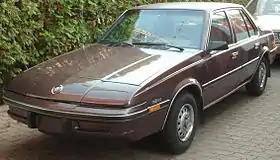 1987 Buick Skyhawk 4-door sedan | |
| Overview | |
| Production | 1981–1989 |
| Model years | 1982–1989 |
| Assembly | United States: Kansas City, Missouri (Leeds Assembly) Janesville, Wisconsin (Janesville GM Assembly Plant) |
| Body and chassis | |
| Class | Compact |
| Body style | 2-door coupe 3-door hatchback 4-door sedan 4-door station wagon |
| Layout | Transverse front-engine, front-wheel drive |
| Platform | J-body |
| Related | Cadillac Cimarron Oldsmobile Firenza Pontiac Sunbird Chevrolet Cavalier |
| Powertrain | |
| Engine | |
| Transmission | 4-speed manual 5-speed manual 3-speed automatic |
| Dimensions | |
| Wheelbase | 101.2 in (2,570 mm) |
| Length | 179.6 in (4,562 mm) (Sedan & coupe) |
| Width | 66.3 in (1,684 mm) 1988–89 Sedan/Coupe/Wagon: 66.0 in (1,676 mm) |
| Height | 52.3 in (1,328 mm) (Coupe) |
The 1982–1989 front-wheel drive Skyhawk (J-body) debuted in February, at the 1982 Chicago Auto Show. The Skyhawk was originally available as a two-door and four-door sedan and was very similar to the Chevrolet Cavalier. The standard engine was a corporate 1.8 liter "122" OHV carbureted four-cylinder (88 hp), with a Brazilian-built 1.8 liter overhead-cam TBI four (84 hp) as an option. A carbureted, 90 hp SOHC two-liter also appeared soon after the Skyhawk went on sale, along with an optional five-speed manual.[3]
The Skyhawk was an entry-level compact platform for a luxury brand, Buick, and was a refocused effort from the previous generation introduced. It followed many economic factors. The United States had entered into a recession, following the effects of the 1970s energy crisis, and the United States Congress having passed the Energy Policy and Conservation Act, establishing Corporate Average Fuel Economy standards. Sales of large luxury sedans declined in favor of smaller, fuel efficient products with luxury features installed. Smaller luxury vehicles were imported into North America from both Europe and Japan, and GM responded with a small luxury sedan.
For 1983, the Brazil-built 1.8-liter gained four hp, while the OHV 1.8 and SOHC 2.0 were replaced by a Chevrolet-built OHV 2.0, also with 90 hp. A four-door station wagon was also introduced, Buick's first front-wheel drive wagon.[4] The next year there was a minor facelift, with bigger cooling openings and larger bumper rub strips. The 2.0 lost four hp, down to 86. Shortly after the introduction of the '84s, a turbocharged MPFI version of the Brazilian 1.8 became available on the T-Type model, offering a hefty 150 hp (112 kW). The turbo T-Type was not available with the five-speed manual. The Skyhawk set a sales record in 1984 with 134,076 built.[5] There was not much change for 1985, but for 1986 a new two-door hatchback was added, in "Sport" or T-Type trim. Also, both 1.8s and 2.0s now claimed the same 88 hp.[6]
The 1.8-liter engines were replaced by two SOHC multi-port injected 2.0 liter versions for 1987, one naturally aspirated (96 hp/71 kW) and one 165 hp (123 kW) turbocharged version known as RPO LT3. The OHV two-liter remained, now with 90 hp.[7] For 1988, only Skyhawk Sports remained, and the hatchback was discontinued. There was also a "Sport S/E" two-door coupe. The OHV and turbocharged engines were no longer available.[8]
_Wagon_facelift_rear.jpg.webp)
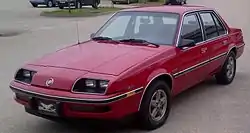
1989 was to be the last year of the Skyhawk, but nonetheless the car received updates such as standard electronic fuel injection, better acoustical insulation and body colored door and window frames on the station wagon.[9] A total of 23,366 '89s were built, for a total of 499,132 second generation Skyhawks.
The Skyhawk, along with variant the Oldsmobile Firenza, were built in Leeds, next of Kansas City, Missouri from 1982 through 1988. 1988 was the last year of Oldsmobile Firenza production and Leeds Assembly was then closed. For 1989, GM moved Skyhawk production to its Janesville, Wisconsin, assembly plant. Production of the Skyhawk ceased after the 1989 model year. The Chevrolet Cavalier was also produced at Leeds for some of these model years.
The last Skyhawk rolled off the assembly line on June 16, 1989. The Skyhawk was the last Buick vehicle to offer a manual transmission option, until the introduction of the Opel Insignia-based 2011 Buick Regal Turbo.
Citations
- h-body.org
- Ward's Automotive Yearbook 1980. Ward's Communications, Inc. 1980.
- John Gunnell (2004). Standard Catalog of Buick, 1903-2004 (3rd ed.). Iola, WI: Krause Publications, Inc. pp. 205–208. ISBN 0-87349-760-0.
- Standard Catalog of Buick, pp. 211–214
- Standard Catalog of Buick, pp. 217–220
- Standard Catalog of Buick, pp. 231–236
- Standard Catalog of Buick, p. 243
- Standard Catalog of Buick, pp. 248–250
- Standard Catalog of Buick, pp. 254–256
General references
- Flammang, James M. & Kowalke, Ron, Standard Catalog of American Cars: 1976–1999, 3rd Edition (Iola, WI: Krause Publications, 1999)
- Gunnell, John, Standard Catalog of American Cars: 1946–1975, Revised 4th Edition (Iola, WI: Krause Publications, 2002)